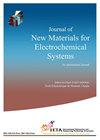Behavior Study of Annealing Temperature on Microstructure and Wettability of Electrodeposited ZnO Thin Films for Microcapacitor Application
IF 0.6
4区 材料科学
Q4 ELECTROCHEMISTRY
Journal of New Materials For Electrochemical Systems
Pub Date : 2022-12-31
DOI:10.14447/jnmes.v25i4.a10
引用次数: 0
Abstract
In this work, electrodeposition was used to produce thin zinc oxide layers on n-type silicon substrates. It has been investigated how annealing at 400∘C affects the deposit's morphological and structural characteristics. SEM, X-ray diffraction, and contact angle measurements have all been used to study the morphology and structure of nonannealed and annealed ZnO. Three intense peaks were visible in the XRD patterns of non-annealed ZnO thin films along the (100), (002) and (101) planes, however these peaks' intensities were different in the XRD patterns of annealed ZnO layers. Furthermore, the 2θ diffraction angle shift can be seen in the XRD patterns of annealed and unannealed ZnO layers. The contact angle measurements showed that the nonannealed ZnO layers are hydrophobic; however, at a temperature of 400∘C for annealing, the ZnO layer surface becomes hydrophilic. Finally, SEM data validate the XRD and contact angle findings by showing how ZnO structure changes from a sand rose shape to a granular structure. Additionally, the ZnO/n− Si micro-capacitor device has been developed and impedance spectroscopy (EIS) has been used to evaluate it. Finally, a microcapacitor made of ZnO and n−Si showed a high specific capacitance of 128mF/g.退火温度对微电容器用电沉积ZnO薄膜微观结构和润湿性的影响
在这项工作中,电沉积被用于在n型硅衬底上制备薄的氧化锌层。已经研究了在400℃退火如何影响沉积物的形态和结构特征。SEM、X射线衍射和接触角测量都已用于研究未退火和退火ZnO的形态和结构。在未退火ZnO薄膜的XRD图谱中,沿(100)、(002)和(101)平面可见三个强烈的峰,但这些峰的强度在退火ZnO层的XRD图谱上不同。此外,在退火和未退火ZnO层的XRD图谱中可以看到2θ衍射角偏移。接触角测量表明,未退火的ZnO层是疏水的;然而,在400℃的退火温度下,ZnO层表面变得亲水。最后,SEM数据通过显示ZnO结构如何从沙玫瑰形状变为颗粒结构来验证XRD和接触角的发现。此外,还开发了ZnO/n−Si微电容器器件,并用阻抗谱(EIS)对其进行了评估。最后,由ZnO和n−Si制成的微电容器显示出128mF/g的高比电容。
本文章由计算机程序翻译,如有差异,请以英文原文为准。
求助全文
约1分钟内获得全文
求助全文
来源期刊

Journal of New Materials For Electrochemical Systems
ELECTROCHEMISTRY-MATERIALS SCIENCE, MULTIDISCIPLINARY
CiteScore
1.90
自引率
0.00%
发文量
33
审稿时长
>12 weeks
期刊介绍:
This international Journal is intended for the publication of original work, both analytical and experimental, and of reviews and commercial aspects related to the field of New Materials for Electrochemical Systems. The emphasis will be on research both of a fundamental and an applied nature in various aspects of the development of new materials in electrochemical systems.
 求助内容:
求助内容: 应助结果提醒方式:
应助结果提醒方式:


